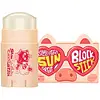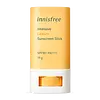What's inside
What's inside
 Key Ingredients
Key Ingredients

 Benefits
Benefits

 Concerns
Concerns

 Ingredients Side-by-side
Ingredients Side-by-side

Octyldodecanol
EmollientDicaprylyl Carbonate
EmollientMethyl Methacrylate Crosspolymer
Ethylhexyl Methoxycinnamate
UV AbsorberDibutyl Lauroyl Glutamide
Skin ConditioningCaprylic/Capric Triglyceride
MaskingOctocrylene
UV AbsorberHomosalate
Skin ConditioningEthylhexyl Salicylate
UV AbsorberDibutyl Ethylhexanoyl Glutamide
Skin ConditioningButyl Methoxydibenzoylmethane
UV AbsorberTocopheryl Acetate
AntioxidantWater
Skin ConditioningLavandula Angustifolia Flower Extract
CleansingMentha Rotundifolia Leaf Extract
TonicMelissa Officinalis Leaf Extract
Skin ConditioningRosmarinus Officinalis Leaf Extract
AntimicrobialChamomilla Recutita Extract
Skin ConditioningMonarda Didyma Leaf Extract
Skin ConditioningSalvia Officinalis Leaf Extract
CleansingMentha Piperita Leaf Extract
Skin ConditioningRosa Centifolia Flower Extract
AstringentOctyldodecanol, Dicaprylyl Carbonate, Methyl Methacrylate Crosspolymer, Ethylhexyl Methoxycinnamate, Dibutyl Lauroyl Glutamide, Caprylic/Capric Triglyceride, Octocrylene, Homosalate, Ethylhexyl Salicylate, Dibutyl Ethylhexanoyl Glutamide, Butyl Methoxydibenzoylmethane, Tocopheryl Acetate, Water, Lavandula Angustifolia Flower Extract, Mentha Rotundifolia Leaf Extract, Melissa Officinalis Leaf Extract, Rosmarinus Officinalis Leaf Extract, Chamomilla Recutita Extract, Monarda Didyma Leaf Extract, Salvia Officinalis Leaf Extract, Mentha Piperita Leaf Extract, Rosa Centifolia Flower Extract
Vinyl Dimethicone/Methicone Silsesquioxane Crosspolymer
Polyethylene
AbrasiveIsopropyl Palmitate
EmollientSilica
AbrasiveSynthetic Fluorphlogopite
Diethylamino Hydroxybenzoyl Hexyl Benzoate
UV FilterTocopheryl Acetate
AntioxidantOzokerite
Emulsion StabilisingBis-Ethylhexyloxyphenol Methoxyphenyl Triazine
Skin ConditioningDehydroacetic Acid
PreservativeTocopherol
AntioxidantWater
Skin ConditioningHamamelis Virginiana Leaf Extract
Skin ConditioningHouttuynia Cordata Extract
Skin ConditioningParfum
MaskingCurcuma Longa Root Extract
MaskingPropylheptyl Caprylate
EmollientBisabolol
MaskingPolyglyceryl-4 Diisostearate/Polyhydroxystearate/Sebacate
EmulsifyingCetyl Ethylhexanoate
EmollientEthylhexyl Palmitate
EmollientHelianthus Annuus Seed Oil
EmollientPropanediol
SolventCitric Acid
BufferingEthylhexyl Salicylate
UV AbsorberPolyurethane-11
Sodium Benzoate
MaskingEthylhexyl Methoxycinnamate
UV AbsorberButyloctyl Salicylate
Skin ConditioningLinalool
PerfumingLimonene
PerfumingVinyldimethicone
Triethoxycaprylylsilane
Benzotriazolyl Dodecyl P-Cresol
UV AbsorberEthylhexyl Triazone
UV AbsorberDicaprylyl Carbonate
EmollientPotassium Sorbate
PreservativeCentella Asiatica Extract
CleansingDistearyldimonium Chloride
Helianthus Annuus Seed Oil Unsaponifiables
EmollientButylphenyl Methylpropional
PerfumingPolysilicone-15
UV FilterEchium Plantagineum Seed Oil
Skin ConditioningSalvia Hispanica Seed Extract
EmollientSaccharide Hydrolysate
HumectantOctyldodecanol
EmollientBenzyl Salicylate
PerfumingDibutyl Adipate
EmollientDimethicone
EmollientCardiospermum Halicacabum Flower/Leaf/Vine Extract
Skin ConditioningHomosalate
Skin Conditioning1,2-Hexanediol
Skin ConditioningLauryl PEG-9 Polydimethylsiloxyethyl Dimethicone
Skin ConditioningPortulaca Oleracea Extract
Skin ConditioningVinyl Dimethicone/Methicone Silsesquioxane Crosspolymer, Polyethylene, Isopropyl Palmitate, Silica, Synthetic Fluorphlogopite, Diethylamino Hydroxybenzoyl Hexyl Benzoate, Tocopheryl Acetate, Ozokerite, Bis-Ethylhexyloxyphenol Methoxyphenyl Triazine, Dehydroacetic Acid, Tocopherol, Water, Hamamelis Virginiana Leaf Extract, Houttuynia Cordata Extract, Parfum, Curcuma Longa Root Extract, Propylheptyl Caprylate, Bisabolol, Polyglyceryl-4 Diisostearate/Polyhydroxystearate/Sebacate, Cetyl Ethylhexanoate, Ethylhexyl Palmitate, Helianthus Annuus Seed Oil, Propanediol, Citric Acid, Ethylhexyl Salicylate, Polyurethane-11, Sodium Benzoate, Ethylhexyl Methoxycinnamate, Butyloctyl Salicylate, Linalool, Limonene, Vinyldimethicone, Triethoxycaprylylsilane, Benzotriazolyl Dodecyl P-Cresol, Ethylhexyl Triazone, Dicaprylyl Carbonate, Potassium Sorbate, Centella Asiatica Extract, Distearyldimonium Chloride, Helianthus Annuus Seed Oil Unsaponifiables, Butylphenyl Methylpropional, Polysilicone-15, Echium Plantagineum Seed Oil, Salvia Hispanica Seed Extract, Saccharide Hydrolysate, Octyldodecanol, Benzyl Salicylate, Dibutyl Adipate, Dimethicone, Cardiospermum Halicacabum Flower/Leaf/Vine Extract, Homosalate, 1,2-Hexanediol, Lauryl PEG-9 Polydimethylsiloxyethyl Dimethicone, Portulaca Oleracea Extract
 Reviews
Reviews

Ingredients Explained
These ingredients are found in both products.
Ingredients higher up in an ingredient list are typically present in a larger amount.
Dicaprylyl Carbonate comes from carbonic acid and caprylyl alcohol, a fatty alcohol. It is an emollient and gives skin a velvet feel. The sources of Dicaprylyl Carbonate may be synthetic or from animals.
As an emollient, Dicaprylyl Carbonate creates a film on the skin. This film traps moisture in, keeping your skin soft and hydrated.
Ethylhexyl Methoxycinnamate is an organic compound that provides UVB protection. It often goes by the more common name of octinoxate. It is created from methoxycinnamic acid and 2-ethylhexanol.
Ethylhexyl Methoxycinnamate absorbs UVB rays with wavelengths between 280-320 nm. UV absorbers protect your skin by using chemical reactions to convert UV rays into heat and energy.
UVB (290-320 nm) rays emit more energy than UVA rays. They are capable of damaging DNA, causing sunburns and are thought to be linked to skin cancer.
The state of Hawaii has banned sunscreens containing octinoxate due to its potential impact on coral reefs. More research is needed to bridge gaps in this research. The European Union allows higher levels of octinoxate in sunscreens than the US and Australia.
Ethylhexyl Methoxycinnamate is oil soluble. It is not stable and may lose efficacy when exposed to sunlight.
Learn more about Ethylhexyl MethoxycinnamateEthylhexyl Salicylate is an organic compound used to block UV rays. It primarily absorbs UVB rays but offers a small amount of UVA protection as well.
Commonly found in sunscreens, Ethylhexyl Salicylate is created from salicylic acid and 2-ethylhexanol. You might know salicylic acid as the effective acne fighter ingredient and BHA.
The ethylhexanol in this ingredient is a fatty alcohol and helps hydrate your skin, similar to oils. It is an emollient, which means it traps moisture into the skin.
According to manufacturers, Ethylhexyl Salicylate absorbs UV wavelength of 295-315 nm, with a peak absorption at 307-310 nm. UVA rays are linked to long term skin damage, such as hyperpigmentation. UVB rays emit more energy and are capable of damaging our DNA. UVB rays cause sunburn.
Learn more about Ethylhexyl SalicylateHomosalate is a chemical sunscreen filter that provides protection in the UV-B range (280nm - 320 nm), with a peak protection at 306 nm. It is internationally approved for use in sunscreens.
Homosalate is not photo-stable, meaning it's strength as a UV filter degrades over time with exposure to the sun. Because of this, it's often used in combination with other chemical sunscreen filters as avobenzone (which protects from the UV-A range). Homosalate also helps act as a solvent for harder-to-dissolve UV filters.
(Part of the reason that sunscreens need to be frequently re-applied is due to the photo instability of many chemical sunscreen filters)
Currently, homosalate is approved in concentrations up to 10% in the EU and 15% in the US. The FDA is currently doing further research on the effects of homosalate, and it is possible that these approved concentrations will change in the future.
Learn more about HomosalateOctyldodecanol is a fatty alcohol. It is primarily used to enhance the texture of products.
As an emulsifier, Octyldodecanol helps prevent the oils and waters from separating. It also prevents ingredients from creating foam when shaken.
Octyldodecanol is created by reducing fatty acid to an alcohol.
Due to its high molecular weight, it does not get absorbed into the skin.
Learn more about OctyldodecanolTocopheryl Acetate is AKA Vitamin E. It is an antioxidant and protects your skin from free radicals. Free radicals damage the skin by breaking down collagen.
One study found using Tocopheryl Acetate with Vitamin C decreased the number of sunburned cells.
Tocopheryl Acetate is commonly found in both skincare and dietary supplements.
Learn more about Tocopheryl AcetateWater. It's the most common cosmetic ingredient of all. You'll usually see it at the top of ingredient lists, meaning that it makes up the largest part of the product.
So why is it so popular? Water most often acts as a solvent - this means that it helps dissolve other ingredients into the formulation.
You'll also recognize water as that liquid we all need to stay alive. If you see this, drink a glass of water. Stay hydrated!
Learn more about Water